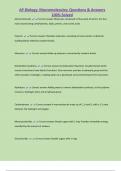Exam (elaborations)
AP Biology: Macromolecules; Questions & Answers 100% Solved
- Course
- Institution
AP Biology: Macromolecules; Questions & Answers 100% Solved Macromolecules Correct answer-Molecules composed of thousands of atoms: the four main classes being carbohydrates, lipids, prteins, and nucleic acids Polymer Correct answer-Chainlike molecules, consisting of many similar or identica...
[Show more]



